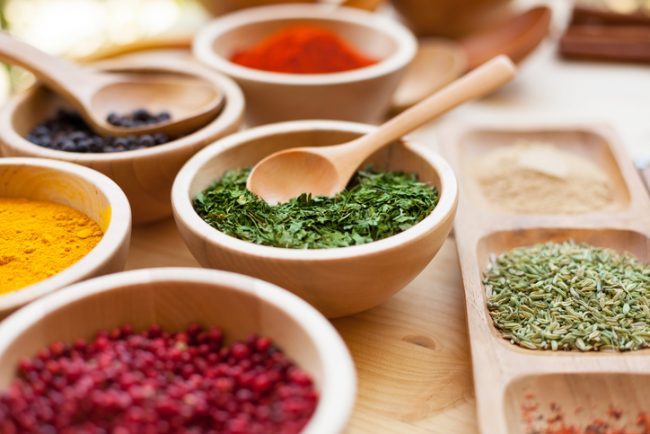“Healthy food” often gets a bad rap for being tasteless and boring. Without the added salt, sugars and fatty ingredients such as butter and excess processed oils, it almost seems like a valid reputation… but it’s not. You don’t have to fry your food or douse your salad in ranch dressing for it to taste good. So you want to know the secret to tasteful, healthy meals? Look no further than your spice rack (and if you’re short on spice, stock up here).
Salt, sugar and fat are additives used to enhance the flavor and appeal of foods. At the same time, this way of eating dramatically decreases the food’s nutritional profile. Preparing food with natural spices and herbs not only has a powerful impact on your health, but on your taste buds, too!
Spices and herbs provide a powerful boost of antioxidants, which are substances that may protect cells from being damaged by unstable molecules knows as free radicals. Consuming antioxidant-rich foods helps support all the hard work your body does for you each day.
Are you ready to spice up your life? Add the following four spices and herbs to your favorite meals:
1. Cinnamon
A staple in most pantries, cinnamon is derived from the inside of evergreen tree bark. Cinnamon may support our body’s processing of glucose from foods.
Try it: Add cinnamon to oatmeal or oven-baked pears to add sweetness without adding sugar. You can also swap sugar for cinnamon in your coffee for an extra punch of warmth and flavor. For a more savory recipe, make a cinnamon-tahini dip with sliced fruit and veggies. Cinnamon is also a delicious addition to baked goods and whole-grain side dishes like cinnamon-orange quinoa porridge.
2. Ginger
Commonly known for its connection to settling upset stomachs, ginger comes from the root of a perennial herb. Ginger is rich in gingerols, a compound related to capsaicin found in chili peppers, which has antioxidant and anti-inflammatory benefits.
Try it: Use ginger in baked goods (like these soft and chewy gingerbread protein cookies!), sprinkle on sweet potatoes, or add into marinades, salad dressings and soups.
3. Cloves
Cloves are the dried and unopened flower buds of a species of evergreen trees. They are a rich source of antioxidant phenolic compounds. Just like cinnamon and ginger, you can add ground cloves to baked goods and oatmeal and sprinkle on top of fruity dishes like homemade applesauce or stewed pears.
4. Sage
Well-known for its addition to popular holiday dishes such as stuffing, this herb has been used in traditional medicine for many years, and recent research shows that sage may support overall health.
Try it: Sage is a great addition to casseroles and roasted vegetables and pairs well with squash and walnuts. For an easy, any-time meal make these lentil-oat patties with fennel and sage.
Whether your spice rack is already stocked, or you are looking to add more to your kitchen arsenal, explore different spices and herbs (beyond the aforementioned four) and decide which ones taste best to you. You can purchase spices and herbs either ground or fresh while others can be grown in a home garden or windowsill herb box.
This article was contributed by Stephanie Chelton, registered dietitian nutritionist, with The Little Clinic.

